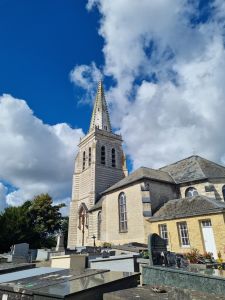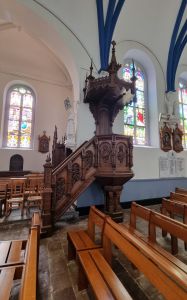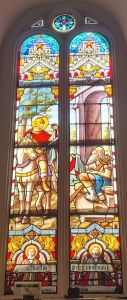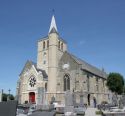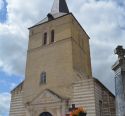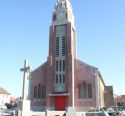Church | 1806 | Neoclassical | Catholic Church






Map
Opening hours
01 April - 30 September
Mon
Tue 10.00 - 18.00
Wed
Thu
Fri 10.00 - 18.00
Sat 10.00 - 18.00
Sun
Also open the weeks before and after Easter and All Saints' Day.
Guided tour
Description
To visit Ruminghem is to discover a local heritage with beautiful farmhouses, a chapel (see details below), traces of contemporary history (launch base), all set in a territory, that of the wateringues and chicory!
Translated with www.DeepL.com/Translator (free version)
Photos
Remarkable elements
The baptismal font
Made of Sainte-Anne marble, a black material native to Belgium, this baptismal font comprises a fluted base and a flared bowl decorated with gadroons (ornamentation in the form of a hollow or projecting moulding) on top of which is a bronze cover.
This 19th-century ensemble has been listed as a Historic Monument since 1973.
Translated with www.DeepL.com/Translator (free version)
The stoup
It has a pouring spout, allowing water to pass through to empty it without fear of spilling on the floor. This stoup is carved from Boulonnais magnesian marble. The bowl is shaped like a mortar bowl with ears and handles.
It has been listed as a Historic Monument since 1973.
Translated with www.DeepL.com/Translator (free version)
The statue of Saint Nicholas
Made of carved polychrome wood from the 17th century, it stands at the entrance to the church behind the baptismal font, protected by a grille.
According to traditional iconography, the bishop is depicted with three children in a salt cellar, in reference to the legend of their resurrection by the saint.
It has been listed as a Historic Monument since 1973.
Translated with www.DeepL.com/Translator (free version)
The statue of Saint Éloi
Made of carved polychrome wood from the late 16th century, it is located at the entrance to the church on the left, protected by a gate.
According to traditional iconography, Saint Éloi is depicted as a bishop with an anvil at his feet, in reference to the miracle of the horseshoe.
The statue has been listed as a Historic Monument since 1973.
Translated with www.DeepL.com/Translator (free version)
The stained glass windows
The stained glass windows were made by master glassmakers from Tournai, a town renowned for its expertise in the art of stained glass. The decorative style reflects that of 19th-century paintings, as well as references to religious symbols. Saint Martin is represented twice, notably in the episode of the cloak shared with a beggar. The other windows are dedicated to passages from the life of the holy family (the Annunciation, the Descent from the Cross, etc.) or to other saints (Saint Michael, Saint Joan of Arc, etc.).
Translated with www.DeepL.com/Translator (free version)
Christ on the cross
Nearly 3 m high and fixed to the outside (south wall of the tower), this Christ on the Cross was built by Louis-Joseph Bomart, mayor of the commune in 1806, who was responsible for rebuilding the church. Funerary plaques bearing the names of members of the Bomart family are placed on either side of the cross.
The cross is protected by a triangular pediment set on columns with composite capitals. Traces of polychrome can be seen in the centre, like a curtain.
The whole has been protected as a Historic Monument since 1973.
Translated with www.DeepL.com/Translator (free version)
Notre-Dame de la Miséricorde chapel (route de Watten)
This small chapel was built in 1947 in gratitude to the Virgin Mary for protecting the village, which had been spared bombing raids on the nearby launch base during the Second World War.
The plans and exterior decoration (stained glass windows) were entrusted to the monks of Wisques Abbey, and the materials came from the Demoor brickworks, established in Ruminghem in the 1930s.
Translated with www.DeepL.com/Translator (free version)
Nearby
Circuit
Restaurant bike rides

Discover the churches in the Calais area that are members of the network by bike...




